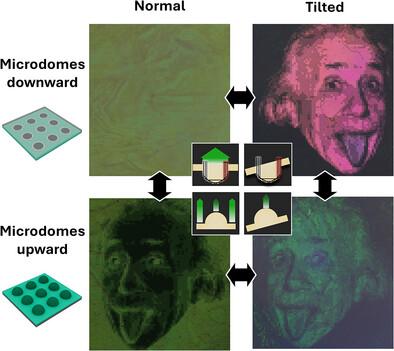Multimodal Structural Color Graphics Based on Colloidal Photonic Microdome Arrays
IF 19
1区 材料科学
Q1 CHEMISTRY, MULTIDISCIPLINARY
引用次数: 0
Abstract
A hybrid structural color platform is presented that integrates colloidal photonic crystals with microscale hemispherical domes to achieve dynamically reconfigurable, multi‐modal visual responses. By combining angle‐dependent Bragg reflection and curvature‐driven total internal reflection (TIR) interference, the system enables four distinct optical states that are reversibly switched by viewing angle and microdome orientation. The microdome‐on‐film architecture is fabricated by molding photocurable silica suspensions into hemispherical dimples, where optimal shear flow enhances colloidal ordering. The optical output—including hue, brightness, and spatial distribution—is programmable by tuning the silica particle diameter at an optimal volume fraction, as well as the radius and areal density of the microdomes. Using these design principles, complex, angle‐sensitive color graphics are demonstrated that remain concealed under normal observation from the film side and are revealed in three distinct modes: tilted observation from the film side, and both normal and tilted observation from the microdome side. This tunable response results from the interplay between periodic nanoscale ordering and mesoscale curvature, providing fundamental insights into a robust and programmable photonic system. The strategy offers a scalable, lithography‐compatible route to functional structural coloration and opens new possibilities for applications in smart labels, anti‐counterfeiting technologies, and tunable optical devices.

基于胶体光子微球阵列的多模态结构彩色图形
提出了一种混合结构颜色平台,将胶体光子晶体与微尺度半球形圆顶集成在一起,以实现动态可重构的多模态视觉响应。通过结合角度相关的Bragg反射和曲率驱动的全内反射(TIR)干涉,该系统实现了四种不同的光学状态,这些状态可以通过视角和微球方向可逆地切换。微球膜结构是通过将可光固化的二氧化硅悬浮液模塑成半球形凹窝来制造的,其中最佳的剪切流增强了胶体的有序性。光输出——包括色调、亮度和空间分布——是可编程的,通过调整最佳体积分数的二氧化硅颗粒直径,以及微圆顶的半径和面密度。利用这些设计原理,复杂的、角度敏感的彩色图形在薄膜侧的正常观察下仍然隐藏,并以三种不同的模式显示:从薄膜侧倾斜观察,以及从微圆顶侧正常和倾斜观察。这种可调谐的响应是由周期性纳米级有序和中尺度曲率之间的相互作用产生的,为稳健的可编程光子系统提供了基本的见解。该策略提供了一种可扩展的、光刻兼容的功能性结构着色途径,并为智能标签、防伪技术和可调光学器件的应用开辟了新的可能性。
本文章由计算机程序翻译,如有差异,请以英文原文为准。
求助全文
约1分钟内获得全文
求助全文
来源期刊

Advanced Functional Materials
工程技术-材料科学:综合
CiteScore
29.50
自引率
4.20%
发文量
2086
审稿时长
2.1 months
期刊介绍:
Firmly established as a top-tier materials science journal, Advanced Functional Materials reports breakthrough research in all aspects of materials science, including nanotechnology, chemistry, physics, and biology every week.
Advanced Functional Materials is known for its rapid and fair peer review, quality content, and high impact, making it the first choice of the international materials science community.
 求助内容:
求助内容: 应助结果提醒方式:
应助结果提醒方式:


